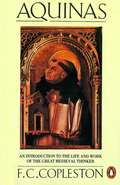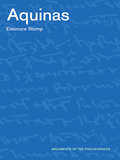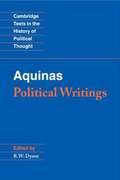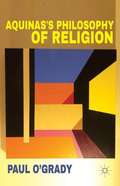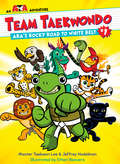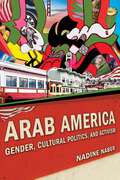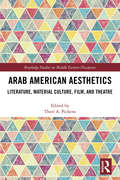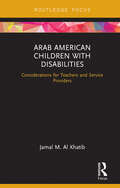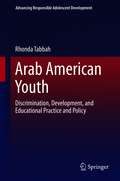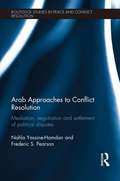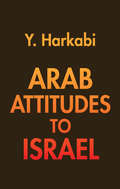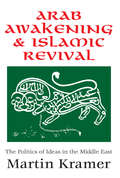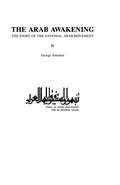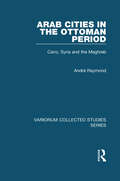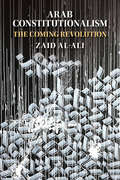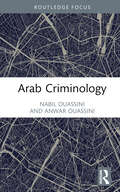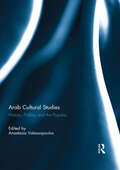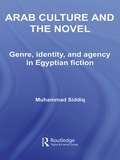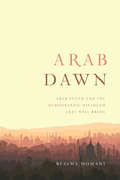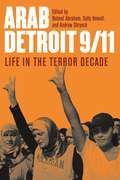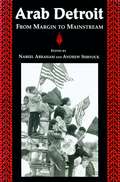- Table View
- List View
Aquinas: An Introduction to the Life and Work of the Great Medieval Thinker
by F. CoplestonAquinas (1224-74) lived at a time when the Christian West was opening up to a wealth of Greek and Islamic philosophical speculation. An embodiment of the thirteenth-century ideal of a unified interpretation of reality (in which philosophy and theology work together in harmony), Aquinas was remarkable for the way in which he used and developed this legacy of ancient thought—an achievement which led his contemporaries to regard him as an advanced thinker. Father Copleston's lucid and stimulating book examines this extraordinary man—whose influence is perhaps greater today than in his own lifetime—and his thought, relating his ideas wherever possible to problems as they are discussed today.
Aquinas: Basic Works (The Hackett Aquinas)
by Thomas Aquinas Robert Pasnau Jeffrey HauseDrawn from a wide range of writings and featuring state-of-the-art translations, Basic Works offers convenient access to Thomas Aquinas' most important discussions of nature, being and essence, divine and human nature, and ethics and human action.The translations all capture Aquinas's sharp, transparent style and display terminological consistency. Many were originally published in the acclaimed translation-cum-commentary series The Hackett Aquinas, edited by Robert Pasnau and Jeffrey Hause. Others appear here for the first time: Eleonore Stump and Stephen Chanderbahn's translation of On the Principles of Nature, Peter King's translation of On Being and Essence, and Thomas Williams' translations of the treatises On Happiness and On Human Acts from the Summa theologiae.Basic Works will enable students to immerse themselves in Aquinas's thought by offering his fundamental works without internal abridgements. It will also appeal to anyone in search of an up-to-date, one-volume collection containing Aquinas' essential philosophical contributions--from the Five Ways to the immortality of the soul, and from the nature of happiness to virtue theory, and on to natural law.
Aquinas: Essays In Honor Of Norman Kretzmann (Arguments of the Philosophers)
by Eleonore StumpFew philosophers or theologians exerted as much influence on the shape of medieval thought as Thomas Aquinas. He ranks amongst the most famous of the Western philosophers and was responsible for almost single-handedly bringing the philosophy of Aristotle into harmony with Christianity. He was also one of the first philosophers to argue that philosophy and theology could support each other. The shape of metaphysics, theology, and Aristotelian thought today still bears the imprint of Aquinas' work.In this extensive and deeply researched study, Eleonore Stump examines Aquinas' major works, Summa Theologiae and Summa Contra Gentiles, and clearly assesses the vast range of Aquinas' thought. Philosophers, theologians, and students of the medieval period alike will find this unrivalled study an indispensable resource in researching and teaching Aquinas.
Aquinas: Political Writings
by Thomas Aquinas R. W. DysonThomas Aquinas (1225-1274) is an extremely influential figure in the history of Western thought and the Catholic church. In this major addition to the Cambridge Texts in the History of Political Thought series, Robert Dyson has translated texts by Aquinas that reflect the complete range of his thinking, and clearly show his development of a Christian version of the philosophy of Aristotle. His translations are supported by brief biographies, notes for further reading and a concise critical introduction.
Aquinas’s Philosophy of Religion
by Paul O’GradyThis is an exploration and analysis of Aquinas's contribution to the philosophy of religion. It examines Aquinas's contexts, his views on philosophy and theology, as well as faith and reason. His arguments for God's existence, responses to objections against God's existence and his characterization of the nature of God are examined.
Aquí era el paraíso / Here Was Paradise: Selección de poemas de Humberto Ak’abal / Selected Poems of Humberto Ak’abal
by Humberto Ak'abalA collection of poetry by one of the greatest Indigenous poets of the Americas about the vanished world of his childhood — that of the Maya K’iche’. Aquí era el paraíso / Here Was Paradise is a selection of poems written by the great Maya poet Humberto Ak’abal. They evoke his childhood in and around the Maya K’iche’ village of Momostenango, Guatemala, and also describe his own role as a poet of the place. Ak’abal writes about children, and grandfathers, and mothers, and animals, and ghosts, and thwarted love, and fields, and rains, and poetry, and poverty, and death. The poetry was written for adults but can also be read and loved by young people, especially in this collection, beautifully illustrated by award-winning Guatemalan-American illustrator Amelia Lau Carling. Ak’abal is famous worldwide as one of the great contemporary poets in the Spanish language, and one of the greatest Indigenous poets of the Americas. Ak’abal created his poems first in K’iche’, then translated them into Spanish. Key Text Features foreword biographical information poems translation Correlates to the Common Core State Standards in English Language Arts: CCSS.ELA-LITERACY.RL.4.2 Determine a theme of a story, drama, or poem from details in the text; summarize the text. CCSS.ELA-LITERACY.RL.5.4 Determine the meaning of words and phrases as they are used in a text, including figurative language such as metaphors and similes. CCSS.ELA-LITERACY.RL.5.5 Explain how a series of chapters, scenes, or stanzas fits together to provide the overall structure of a particular story, drama, or poem. CCSS.ELA-LITERACY.RL.5.7 Analyze how visual and multimedia elements contribute to the meaning, tone, or beauty of a text (e.g., graphic novel, multimedia presentation of fiction, folktale, myth, poem). CCSS.ELA-LITERACY.RL.6.2 Determine a theme or central idea of a text and how it is conveyed through particular details; provide a summary of the text distinct from personal opinions or judgments. CCSS.ELA-LITERACY.RL.6.5 Analyze how a particular sentence, chapter, scene, or stanza fits into the overall structure of a text and contributes to the development of the theme, setting, or plot.
Ar'n't I a Woman?: Female Slaves in the Plantation South (Revised Edition)
by Deborah Gray White"This is one of those rare books that quickly became the standard work in its field. Professor White has done justice to the complexity of her subject."--Anne Firor Scott, Duke University Living with the dual burdens of racism and sexism, slave women in the plantation South assumed roles within the family and community that contrasted sharply with traditional female roles in the larger American society. This new edition of Ar'n't I a Woman? reviews and updates the scholarship on slave women and the slave family, exploring new ways of understanding the intersection of race and gender and comparing the myths that stereotyped female slaves with the realities of their lives. Above all, this groundbreaking study shows us how black women experienced freedom in the Reconstruction South -- their heroic struggle to gain their rights, hold their families together, resist economic and sexual oppression, and maintain their sense of womanhood against all odds.
Ara's Rocky Road to White Belt (Team Taekwondo #1)
by Ethen Beavers Master Taekwon Lee Jeffrey Nodelman<P>Ara is the odd turtle out in his family, preferring his rock collection to new or wild adventures—until he meets Baeoh, a confident tiger who practices martial arts. <p>Unsure if he has what it takes to join Baeoh’s taekwondo team, Ara must learn how to come out of his shell, persist through failure, and accept the help of his new friends to complete the Tiger Fitness Challenge. <p>The Team Taekwondo series combines the appeal of graphic novels and martial arts to deliver action-filled, character-building stories. <p>Each book also includes one free lesson at any participating licensed ATA Martial Arts location. <P><P> <i>Advisory: Bookshare has learned that this book offers only partial accessibility. We have kept it in the collection because it is useful for some of our members. Benetech is actively working on projects to improve accessibility issues such as these.</i>
Arab America: Gender, Cultural Politics, and Activism (Nation of Nations #13)
by Nadine NaberArab Americans are one of the most misunderstood segments of the U.S. population, especially after the events of 9/11. In Arab America, Nadine Naber tells the stories of second generation Arab American young adults living in the San Francisco Bay Area, most of whom are political activists engaged in two culturalist movements that draw on the conditions of diaspora, a Muslim global justice and a Leftist Arab movement.Writing from a transnational feminist perspective, Naber reveals the complex and at times contradictory cultural and political processes through which Arabness is forged in the contemporary United States, and explores the apparently intra-communal cultural concepts of religion, family, gender, and sexuality as the battleground on which Arab American young adults and the looming world of America all wrangle. As this struggle continues, these young adults reject Orientalist thought, producing counter-narratives that open up new possibilities for transcending the limitations of Orientalist, imperialist, and conventional nationalist articulations of self, possibilities that ground concepts of religion, family, gender, and sexuality in some of the most urgent issues of our times: immigration politics, racial justice struggles, and U.S. militarism and war.For more, check out the author-run Facebook page for Arab America.
Arab American Aesthetics: Literature, Material Culture, Film, and Theatre (Routledge Studies on Middle Eastern Diasporas)
by Therí A. PickensArab American Aesthetics enlists a wide range of voices to explore, if not tentatively define, what could constitute Arab American aesthetics in literature, material culture, film, and theatre. This book seeks to unsettle current conversations within Arab American Studies that neglect aesthetics as a set of choices and constraints. Rather than divorce aesthetics from politics, the book sutures the two more closely together by challenging the causal relationship so often attributed to them. The conversations include formal choices, but also extend to the broad idea of what makes a work distinctly Arab American. That is, what about its beauty, ugliness, sublimity, or humor is explicitly tied to it as part of a tradition of Arab American arts? The book opens up the ways that we discuss Arab American literary and fine arts, so that we understand how Arab American identity and experience begets Arab American artistic enterprise. Split into three sections, the first offers a set of theoretical propositions for understanding aesthetics that traverse Arab American cultural production. The second section focuses on material culture as a way to think through the creation of objects as an aesthetic enterprise. The final section looks at narratives in theatre and how the impact of such a medium has the potential to recreate in both senses of the word: play and invention. By shifting the conversation from identity politics to the relationship between politics and aesthetics, this book provides an important contribution to Arab American studies. It will also appeal to students and scholars of ethnic studies, museum studies, and cultural studies.
Arab American Children with Disabilities: Considerations for Teachers and Service Providers
by Jamal M. Al KhatibDespite a proliferation of special education literature on racial minorities over the past three decades, research and writing on Arab American children with disabilities remain remarkably sparse. This book fills that gap by promoting culturally appropriate services for Arab American children with disabilities. Special education and service providers in the U.S.—including school psychologists, rehabilitation counselors, and social workers—are increasingly likely to work with Arab Americans with disabilities. By focusing on this marginalized minority population, Al Khatib provides much-needed context and direction for service providers and researchers working with the Arab American community. Offering an overview of special education and the rights guaranteed under the Individuals with Disabilities Education Act (IDEA), this book also helps Arab American families understand the special education process and advocate for their children.
Arab American Youth: Discrimination, Development, and Educational Practice and Policy (Advancing Responsible Adolescent Development)
by Rhonda TabbahThis book examines the implications of discrimination in Arab American youth with a focus on K-12 school systems. It begins with an introduction to Arab American youth and their experiences in the education system. The book follows with an overview regarding historical contributions of discrimination and the history of discrimination against Arabs in America, including the education system. It then presents relevant theoretical perspectives regarding discrimination and developmental processes. The book examines research specific to Arab American youth, identifies research limitations, and provides strategies on how to strengthen methodological approaches to better inform research, practice, and policy. It concludes by offering strategies for improving educational practice and policy and recommendations for interventions designed to enhance developmental health of Arab American youth in schools.Key areas of coverage include:Arab American youth, development, and discrimination in America.Discrimination in the K-12 educational system.Self-concept, ethnic identity, well-being and discrimination among Arab American youth.Arab American Youth is an essential resource for practitioners, researchers, educators, and related professionals as well as graduate students in school psychology, educational psychology, education, and related disciplines.______________________________________________________________________Dr. Tabbah has written a book that is well overdue … she provides a blueprint for moving forward in education as well as in policy development that can be transformative for Arab-American youth. Antoinette Miranda, Professor of School Psychology, The Ohio State University This book is a valuable contribution given the nascent literature on the experiences of Arab youth and the significant impact of discrimination on their schooling. Desiree Vega, Associate Professor of School Psychology, University of Arizona
Arab Americans in the United States: Immigration, Culture and Health (International Perspectives on Migration)
by Shaikha H. Al-KuwariThis open access book provides a unique perspective on the relationship between immigration, culture, and health. It presents a cross-cultural perspective between culture and illness. It touches upon identity struggles, the notion of not feeling “safe, understood, accepted,” and its relation to Arab American health. The book provides a comprehensive review of the history of Muslims in America and discusses better healthcare services for chronic illness—diabetes. It provides an ethnographic framework for building cultural belief models of illness, which helps study any illness among any population. It is a must-read for everyone interested in understanding the relationship among culture, health, and immigration, as well as the importance of building cultural belief models of illness and their possible impact on providing better healthcare services. The book is of interest to scholars, caregivers, and those living with diabetes.
Arab Approaches to Conflict Resolution: Mediation, Negotiation and Settlement of Political Disputes (Routledge Studies in Peace and Conflict Resolution)
by Frederic S Pearson Nahla Yassine-HamdanThis book examines Arab approaches to mediation, negotiation and settlement of political disputes. This book proposes that two clusters of independent variables are potentially responsible for the distinctive nature of Arab conflict resolution. Firstly, those linked with Arab political regimes and imperatives, and secondly those linked with Arab and /or Islamic culture. The text also focuses on the Arab League and its history of involvement in crisis and conflict situations, along with the roles of individual leaders, emissaries and extra-regional actors such as IGOs (Inter-Governmental Organisations) in undertaking mediation initiatives. IGO and Arab League activity has taken on new importance since the various intervention attempts in connection with the 'Arab Spring' since 2011. During the negotiation process, most Arab regimes tend to view conflicts within a broad historical context and Islamic culture prioritises the cohesion of the community and internal stability of the state over individual autonomy. This has created an authoritarian style of leadership, and in practice, leaders in the Middle East have had near absolute authority in the decision-making process—a fact which will have a lot of weight in conflict management and whether peace will endure for a long period of time. This book is unique in studying these clusters through comparative systematic case study analysis of events prior to and subsequent to the 'Arab Spring', augmented by a quantitative analysis of sample data on Arab disputes, compiled from a larger and newly augmented study comprising the years 1945-2000. Complementary data from the Uppsala Conflict Data Program’s (UCDP) data base of armed conflicts since 1975 is also utilized. This book will be of much interest to students of conflict resolution, peace and conflict studies, Middle Eastern politics and IR in general.
Arab Attitudes to Israel
by Yehoshafat HarkabiBecause of recent changes in the explicitly declared goals of Arabs in the Palestinian conflict, this book is of singular importance, and no scholar or expert on Middle East affairs can afford to ignore it. This work, by a scholar described as "the doyen of Israeli Arabists," is the result of vast research into the attitude of the Arabs toward Israel, manifested both in their declared, explicit aims and in ideological exegeses on the roots of the Palestinian problem. Approximately one hundred twenty books written by Arabs and the Arab press and radio are herein analyzed. Harkabi's searching examination is objective. His detection of consistent patterns in what at first seems amorphous is convincing. If there is such a thing as a science of political psychology, Harkabi is its master.
Arab Awakening and Islamic Revival: The Politics of Ideas in the Middle East
by Thomas MolnarOver the past decade, the political ground beneath the Middle East has shifted. Arab nationalism the political orthodoxy for most of this century has lost its grip on the imagination and allegiance of a new generation. At the same time, Islam as an ideology has spread across the region, and "Islamists" bid to capture the center of politics. Most Western scholars and experts once hailed the redemptive power of Arabism. Arab Awakening and Islamic Revival is a critical assessment of the contradictions of Arab nationalism and Islamic fundamentalism, and the misrepresentation of both in the West.The first part of the book argues that Arab nationalism--the so-called Arab awakening--bore within it the seeds of its own failure. Arabism as an idea drew upon foreign sources and resources. Even as it claimed to liberate the Arabs from imperialism it deepened intellectual dependence upon the West's own romanticism and radicalism. Ultimately, Arab nationalism became a force of oppression rather than liberation, and a mirror image of the imperialism it defied. Kramer's essays together form the only chronological telling and the at fully documented postmortem of Arabism. The second part of the book examines the similar failings of Islamism, whose ideas are Islamic reworkings of Western ideological radicalism. Its effect has been to give new life to old rationales for oppression, authoritarianism, and sectarian division.Arab Awakening and Islamic Revival provides an alternative view of a century of Middle Eastern history. As the region moves fitfully past ideology, Kramer's perspective is more compelling than at any time in the past-in Western academe no less than among many in the Middle. This book will be of interest to sociologists, political scientists, economists, and Middle East specialists.
Arab Awakening: The Story Of The Arab National
by AntoniusFirst published in 2001. Routledge is an imprint of Taylor & Francis, an informa company.
Arab Cities in the Ottoman Period: Cairo, Syria and the Maghreb (Variorum Collected Studies)
by André RaymondProfessor Raymond deals here with the evolution of the great Arab cities of the Ottoman period (1516-1800) - with questions of organisation, social life and the built space - looking in particular at Aleppo, Algiers, Constantine and, above all, at Cairo. These studies form part of a movement, in which the author’s work has played a significant role, aiming to re-examine the traditional Orientalist view of ’Muslim cities’. Contrary to the negative perception one so often finds, of decadent and chaotic towns, it can be seen that they had a coherent internal structure and that, far from being in decline, they enjoyed renewed prosperity in the Ottoman era, benefiting from the strength of the empire and flourishing Mediterranean trade. This in turn was reflected in the important and original architectural activity of the period.
Arab Constitutionalism: The Coming Revolution
by Zaid Al-AliAfter the 2011 uprisings started in Tunisia and swept across the Arab region, more than a dozen countries amended their constitutions, the greatest concentration of constitutional reform processes since the end of the Cold War. This book provides a detailed account and analysis of all of these developments. Individual accounts are provided of eight different reform processes (including Tunisia, Egypt, Libya, Yemen and Sudan), with particular focus on the historical context, the political dynamics, the particular process that each country followed and the substantive outcome. Zaid Al-Ali deconstructs the popular demands that were made in 2011 and translates them into a series of specific actions that would have led to freer societies and a better functioning state. A revolution did not take place in 2011, but it is inevitably part of the region's future and Arab Constitutionalism explores what that revolution could look like.
Arab Criminology (Criminology in Focus)
by Nabil Ouassini Anwar OuassiniThe objective of Arab Criminology is to establish a criminological sub-field called ‘Arab Criminology.’ The ever-evolving field of criminology has advanced in the past decade, yet many impediments remain. Unlike criminology in Africa, Asia, the Americas, Europe, and Oceania based merely on geopolitical constructs, the Arab world has unique commonalities that do not exist in the other established sub-fields on criminology. The Arab world has largely remained in criminology’s periphery despite the region’s considerable importance to current international affairs. In response, this book explores two main questions: Why should we and how do we establish a sub-field in Arab Criminology? The authors examine the state of criminology in the Arab world, define its parameters, and present four components that bond and distinguish Arab criminology from other criminological area studies. They then identify the requirements for establishing Arab criminology and detail how local, regional, and international researchers can collaborate, develop, and expand the sub-field. Arab Criminology will challenge some of the recurrent Orientalist and Islamophobic tropes in Northern criminology and progress the discipline of criminology to reflect a more diverse focus that embraces regions from the Global South. Presenting compelling arguments and examples that support the establishment of this sub-field, Arab Criminology will be of great interest to Criminology, Criminal Justice, Legal Studies, and Middle Eastern/North African studies scholars, particularly those working on Southern Criminology, Comparative Criminology, International Criminal Justice Systems, and Arab studies.
Arab Cultural Studies: History, Politics and the Popular
by Anastasia ValassopoulosThis book seeks to both showcase and further develop innovative research and debates on contemporary Arab cultural production. Popular culture in the form of cinema, popular music, literature, visual media and cyber-cultures, both local and imported, enjoy a central role in Arab cultural life, and the contributors to this innovative collection showcase the tremendous cultural output emerging from the Arab world. They present sensitive, conceptual readings whilst remaining mindful of the place of this work within a wider framework that seeks to prevent isolationist readings of cultural phenomena. Making sense of the place of culture in the Arab world, and agreeing upon a broadly recognisable and commonly accepted set of terms within which to discuss this output, is a new and urgent challenge. Arab Cultural Studies aspires to understand, communicate and theorise these forms. This book was originally published as a special issue of the Journal for Cultural Research.
Arab Culture and the Novel: Genre, Identity and Agency in Egyptian Fiction (Routledge Studies in Middle Eastern Literatures #Vol. 16)
by Muhammad SiddiqThis book explores the complex relationship between the novel and identity in modern Arab culture against a backdrop of contemporary Egypt. It uses the example of the Egyptian novel to interrogate the root causes – religious, social, political, and psychological – of the lingering identity crisis that has afflicted Arab culture for at least two centuries.
Arab Dawn
by Bessma MomaniIn the West, news about the Middle East is dominated by an endless stream of reports and commentary about civil war, sectarian violence, religious extremism, and economic stagnation. But do they tell the full story? For instance, who knew that university enrolment in the war-torn Palestinian territories exceeds that of Hong Kong, or that more than a third of Lebanese entrepreneurs are women?Change is on its way in the Middle East, argues Bessma Momani, and its cause is demographic. Today, one in five Arabs is between the ages of fifteen and twenty-four. Young, optimistic, and increasingly cosmopolitan, their generation will shape the region's future. Drawing on interviews, surveys, and other research conducted with young people in fifteen countries across the Arab world, Momani describes the passion for entrepreneurship, reform, and equality among Arab youth. With insightful political analysis based on the latest statistics and first-hand accounts, Arab Dawn is an invigorating study of the Arab world and the transformative power of youth.
Arab Detroit 9/11: Life in the Terror Decade
by Andrew Shryock Nabeel Abraham Sally HowellSince the terrorist attacks of September 11, 2001, Detroit's large and nationally prominent Arab and Muslim communities have faced heightened prejudice, government surveillance, and political scapegoating, yet they have also enjoyed unexpected gains in economic, political, and cultural influence. Museums, festivals, and cultural events flourish alongside the construction of new mosques and churches, and more Arabs are being elected and appointed to public office. Detroit's Arab population is growing even as the city's non-Arab sectors, and the state of Michigan as a whole, have steadily lost population. In Arab Detroit 9/11: Life in the Terror Decade, a follow-up to their volume Arab Detroit: From Margin to Mainstream (Wayne State University Press, 2000), editors Nabeel Abraham, Sally Howell, and Andrew Shryock present accounts of how life in post-9/11 Detroit has changed over the last ten years.Abraham, Howell, and Shryock have assembled a diverse group of contributors whose essays range from the scholarly to the artistic and include voices that are Palestinian, Iraqi, Yemeni, and Lebanese; Muslim and Christian; American born and immigrant. The book is divided into six sections and begins with wide-angle views of Arab Detroit, looking first at how the community fits within greater Detroit as a whole, then presenting closer portraits of Arab Detroit's key ethnonational and religious subgroups. More personal, everyday accounts of life in the Terror Decade follow as focus shifts to practical matters such as family life, neighborhood interactions, going to school, traveling domestically, and visiting home countries. Finally, contributors consider the interface between Arab Detroit and the larger society, how this relationship is maintained, how the War on Terror has distorted it, and what lessons might be drawn about citizenship, inclusion, and exclusion by situating Arab Detroit in broader and deeper historical contexts.Readers interested in Arab studies, Detroit culture and history, transnational politics, and the changing dynamics of race and ethnicity in America will enjoy the personal reflection and analytical insight of Arab Detroit 9/11.
Arab Detroit: From Margin to Mainstream
by Andrew Shryock Nabeel AbrahamMetropolitan Detroit is home to one of the largest, most diverse Arab communities outside the Middle East, yet the complex world Arabic-speaking immigrants have created there is barely visible on the landscape of ethnic America. In this volume, Nabeel Abraham and Andrew Shryock bring together the work of twenty-five contributors to create a richly detailed portrait of Arab Detroit. The book goes behind the bulletproof glass in Iraqi Chaldean liquor stores. It explores the role of women in a Sunni mosque and the place of nationalist politics in a Coptic church. It follows the careers of wedding singers, Arabic calligraphers,restaurant owners, and pastry chefs. It examines the agendas of Shia Muslim activists and Washington-based lobbyists and looks at the intimate politics of marriage, family honor, and adolescent rebellion. Memoirs and poems by Lebanese, Chaldean, Yemeni, and Palestinian writers anchor the book in personal experience, while over fifty photographs provide a backdrop of vivid, often unexpected, images. In their efforts to represent an ethnic/immigrant community that is flourishing on the margins of pluralist discourse, the contributors to this book break new ground in the study of identity politics, transnationalism, and diaspora cultures.
